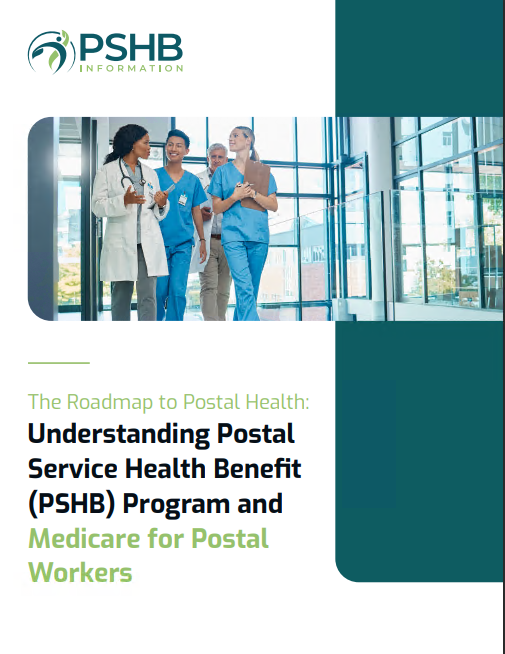Key Takeaways
-
PSHB copayments vary widely based on the type of service, whether it’s routine care, emergencies, or specialty visits. Knowing these costs helps you make better decisions about your healthcare.
-
Some plans reward coordination with Medicare, potentially lowering your out-of-pocket expenses for services like emergency room visits and prescription drugs.
Understanding Copayments in PSHB Plans
As a Postal Service employee or annuitant, your health benefits come under the Postal Service Health Benefits (PSHB) Program. One critical cost-sharing element you’ll encounter across plans is copayments. These are fixed amounts you pay out-of-pocket for specific healthcare services—but not all plans charge the same copayments, and understanding the differences can help you better plan your expenses.
What Are Copayments and Why Do They Matter?
Copayments, or copays, are the flat fees you pay for healthcare services, such as a visit to the doctor, a prescription, or an emergency room visit. They’re different from deductibles, which you must pay before your plan begins covering certain costs, and coinsurance, which is a percentage of costs you share with the plan after meeting your deductible.
Knowing what you’ll pay in copayments can influence your decisions—like which doctor you see or whether to seek care at an urgent care center versus the emergency room. With PSHB plans, understanding these details helps you manage your budget and avoid surprise medical bills.
Common Healthcare Services and What You’ll Pay
Let’s break down the most common types of care and the expected copayments across different PSHB plans in 2025. Keep in mind that these amounts are general ranges—specific costs depend on your chosen plan.
1. Primary Care Visits
Seeing your primary care provider (PCP) is often the most affordable service. Copayments for routine check-ups or sick visits typically range between $20 and $40 for in-network providers. If you choose to go out-of-network, you may pay significantly more, or your plan might not cover the visit at all.
Why This Matters:
Regular visits to your PCP are essential for preventive care, like screenings and vaccinations. Lower copayments make it easier to stay proactive about your health without worrying about excessive out-of-pocket costs.
2. Specialist Visits
Specialists—like dermatologists, cardiologists, or physical therapists—come with higher copayments than PCPs. In-network specialist visits usually range from $30 to $60. Like with primary care, seeing an out-of-network specialist can result in much higher costs.
Pro Tip:
Some plans require a referral from your PCP to see a specialist. Confirm with your plan to avoid paying unnecessary fees.
3. Emergency Room (ER) Services
Emergency rooms offer life-saving care but come with some of the highest copayments. In-network ER visits typically cost $100 to $150. If your visit isn’t deemed a true emergency, you might face higher out-of-pocket charges or even be responsible for the entire bill.
Consider Alternatives:
Urgent care centers are often a cost-effective option for non-life-threatening conditions, with copayments ranging between $50 and $75. It’s worth checking your plan’s specific cost structure to determine when urgent care is a better choice.
4. Prescription Drugs
Copayments for prescription drugs depend on their tier—generic, brand-name, or specialty. Generic drugs generally have the lowest copayments, around $10 to $15, while specialty medications can cost significantly more.
Key Tip:
Using your plan’s preferred pharmacy network can help lower your costs, as out-of-network pharmacies might not be covered.
Preventive Care: What’s Covered with No Copayment?
Preventive services, such as screenings, immunizations, and annual wellness visits, are often covered without any copayments under most PSHB plans. This aligns with federal regulations that prioritize preventive care to improve overall health outcomes.
Examples of Covered Preventive Services:
-
Flu shots
-
Mammograms
-
Annual physicals
-
Diabetes screenings
Make sure you visit an in-network provider to take advantage of these benefits without incurring additional costs.
Managing High-Cost Services
Certain services, like hospital stays or outpatient surgeries, come with higher costs. Understanding these copayments ensures you’re financially prepared for significant medical needs.
1. Inpatient Hospital Stays
For hospital admissions, you’ll likely face a daily copayment for the first several days. These charges can range from $250 to $500 per day for in-network care. Out-of-network costs are typically much higher.
Action Plan:
Check whether your hospital is in-network and confirm coverage details before planned procedures. Pre-authorization may also be required to avoid denied claims.
2. Outpatient Surgery
Outpatient procedures, such as colonoscopies or cataract surgeries, often have flat-rate copayments ranging from $100 to $300. Again, costs are lower for in-network providers.
Why Plan Ahead?
Scheduling procedures with in-network facilities and providers can significantly reduce your out-of-pocket expenses.
Mental Health Services
Mental health care is increasingly recognized as essential, and most PSHB plans provide robust coverage for these services.
Copayments for Mental Health Care
-
In-Network Therapy Sessions: $20 to $40 per session
-
Outpatient Programs: $50 to $150 per visit
-
Inpatient Psychiatric Care: Daily copayments similar to regular hospital stays
Important Note:
Mental health parity laws require that coverage for mental health services is comparable to physical health services. If you’re unsure about your plan’s mental health benefits, consult your plan brochure or contact customer service.
Dental and Vision Services: What to Expect
While not all PSHB plans include dental and vision coverage, many offer optional add-ons. These benefits often come with their own set of copayments and limitations.
Dental Care Copayments
-
Routine cleanings: $0 to $50
-
Fillings: $25 to $100
-
Major services (e.g., crowns, root canals): $150 to $500
Vision Care Copayments
-
Annual eye exams: $20 to $40
-
Frames and lenses: Copayments or discounts vary widely
Tip:
If your PSHB plan doesn’t include dental or vision coverage, you may want to explore stand-alone FEDVIP (Federal Employees Dental and Vision Insurance Program) options.
Copayments and Medicare Coordination
If you’re enrolled in Medicare Part B alongside your PSHB plan, your out-of-pocket costs might decrease for certain services. Many PSHB plans waive or reduce copayments for Medicare enrollees, particularly for inpatient and outpatient services.
Medicare’s Impact on Copayments:
-
Emergency Room Visits: Lower copayments or full coverage after Medicare pays its share
-
Outpatient Surgery: Reduced copayments for most procedures
-
Mental Health Services: Enhanced coverage with minimal out-of-pocket costs
Remember:
Always present both your Medicare and PSHB cards at the time of service to ensure proper coordination of benefits.
Planning for Unexpected Costs
Even with detailed copayment information, healthcare costs can still catch you off guard. Here are some strategies to stay ahead:
1. Understand Your Out-of-Pocket Maximum
Every PSHB plan has an annual out-of-pocket maximum that caps what you’ll pay in copayments, deductibles, and coinsurance. Once you reach this limit, the plan covers 100% of covered services for the rest of the year.
-
In-Network Maximums: $7,500 for Self Only plans and $15,000 for Self Plus One or Family plans
-
Out-of-Network Maximums: Often higher or uncapped
2. Keep Track of Healthcare Expenses
Use online portals or mobile apps provided by your plan to monitor your copayments and progress toward your deductible and out-of-pocket maximum.
3. Save with Flexible Spending Accounts (FSAs)
If eligible, an FSA can help you save on copayments using pre-tax dollars. Be sure to elect contributions during Open Season and monitor your balance throughout the year.
Make the Most of Your PSHB Plan
Understanding copayments across different services—from routine care to emergencies—empowers you to make informed healthcare decisions. By knowing what to expect, you can avoid unexpected bills and focus on maintaining your health.
Take the time to review your plan’s brochure, compare in-network versus out-of-network costs, and consider how Medicare coordination might reduce your expenses. The more proactive you are, the better prepared you’ll be to handle whatever healthcare needs come your way.










